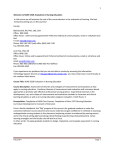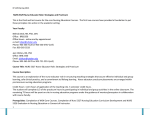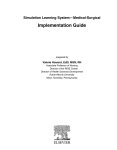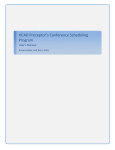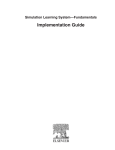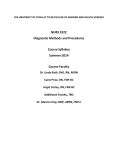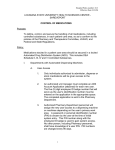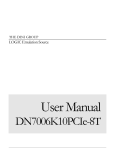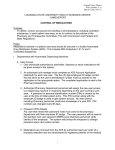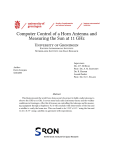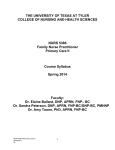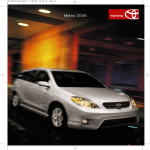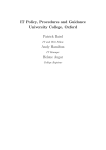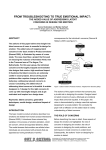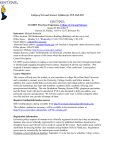Download NURS 5329 - Nurse Educator Role - The University of Texas at Tyler
Transcript
N 5329 Fall 2015 NURS 5329 Nurse Educator Role: Strategies and Practicum Fall 2015 Course Description: Preamble: This is the third and last course for the core Nursing Education Courses. The first two courses have provided a foundation to put these principles into action in the academic setting. Course Description: This course is an exploration of the nurse educator role in structuring teaching strategies that assure effective individual and group learning, safe clinical practice, and a commitment to lifelong learning. Nurse educator practicum placements are arranged within pre-licensure nursing education programs. Course Credit: Pre-requisite courses: Class Meeting Time: Instructor(s): Contact Information: Office Hours: Required Materials: Recommended Materials: Course Format: Student Resources Credit Hours: 112.5 hours of application of the teaching role. 3 semester credit hours. The student will complete 9.5 of the practicum hours by participating in individual and group activities in the online classroom. The remaining 103 hours will be spent on-site in nursing education programs under the guidance of mentors/preceptors in collaboration with course faculty. 3 Completion of MSN Core Courses. Completion of Nurs 5327 Nursing Education Curriculum Development and NURS 5328 Evaluation in Nursing Education or Consent of Instructor. Online, Blackboard, Zoom sessions Jerri Post, PhD, RN Office: BRB 1100 Office Hours: online and by appointment Preferred method of communication, email or cell phone and text E-mail: [email protected] Phone: 870-260-2276 (cell) Fax: 903-565-5533 Online as needed, will set up phone conferences and Zoom sessions as needed Oermann, M.H. (2015). Teaching in nursing and the role of the educator: The complete guide to best practice in teaching, evaluation, and curriculum development. New York: Springer Publishing Company. ISBN: 9780826195531 McDonald, M. E. (2014). The nurse educator's guide to assessing learning outcomes. (3rd ed.). Sudberry, MA: Jones and Bartlett. Benner, P., Sutphen, M., Leonard, V., Day, L. (2010). Educating nurses: A call for radical transformation. San Francisco: Jossey-Bass. American Psychological Association. (2009). Publication manual of the American Psychological Association. (6th ed.). Washington, D.C.: Author. ISBN 1433805618 Booklists and bookstore links may be accessed at the UT Tyler College of Nursing Graduate Studies page. Certified Nurse Educator (CNE) 2014 Candidate Handbook http://www.nln.org/certification/handbook/cne.pdf The Scope of Practice for Academic Nurse Educators 2012 Revision ISBN/ISSN: 9781934758175 (available on the NLN website cost approx. $20) For the future: Books from the Certified Nurse Exam Helpful References List from LSU http://libguides.lsuhsc.edu/content.php?pid=342727&sid=3285623 Via Blackboard site: Lectures, case studies, group discussion, portfolio completion. Development of teaching activities including lecture and clinical settings in conjunction with face to face faculty preceptor at pre-licensure nursing program. http://lms-media.uttyler.edu/fileman/OID/Resource/skills.html Page 1 of 13 N 5329 Fall 2015 for Online and Hybrid Courses: Student Learning Outcomes: Grading Policies: Including technical skills needed to be successful, Blackboard Support, Netiquette, Quick References, and University Policies Upon successful completion of the course, the student will able to: 1. Apply concepts of role theory to the advanced practice roles of nurse educators including teaching, service, and scholarship. 2. Demonstrate the ability to integrate nursing education theories and teaching/learning strategies to facilitate students’ assimilation of knowledge and safe clinical practice. 3. Use established and innovative educational processes to design, implement, and evaluate educational offerings, which incorporate the promotion of critical thinking and creative use of resources. 4. Apply theories, principles, and strategies of teaching and learning in ways that meet the needs of diverse learning styles. 5. Analyze current health care, nursing, and nursing education issues, trends, and standards for relevancy to nurse educator roles. Grading Information and Course Requirements Final grades for the course will be determined based upon the following point assignments: A - 90-100 B - 80-89 C - 70-79 D - 60-69 F - Below 60 Five (5) points will be deducted for each day an assignment is late (including weekends) if prior arrangements have not been made with the course instructors. Final assignments for the course must be submitted on time, i.e. will not be accepted late. Reading Assignments: Assigned readings in graduate education are the beginning, not the endpoint. These readings will point you in the direction of continued reading and pondering of your scholarly thoughts. Each participant is responsible for completing the reading assignments in a timely manner. Deadlines are listed in the Course Schedule. Grading Criteria: Discussion and written assignments are made with the assumption that required reading assignments are completed prior to completion of discussion and written assignments. Assignment Grade Percentage DB 1 5 DB 2 5 DB 3 5 Teaching Plan 15 Teaching Documentation 15 Exam Administration/Analysis 10 Clinical Plan 15 Clinical Documentation 15 Faculty Development Documentation 10 Portfolio 5 Overall Clinical Performance Pass/Fail Total 100 Page 2 of 13 N 5329 Fall 2015 NURS 5329 Nurse Educator Role: Strategies and Practicum Course Outline Fall 2015 BBD postings and assignments All assignments due Tuesday at midnight of week designated Reading assignments, Schedule meeting with preceptor see Assignments: Course Overview DB post Wk 1 Reading assignments DB post Wk 2 Reading Assignments DB post Wk 3 Teaching Plan or Clinical Plan Week Dates 8/24/2015 Content First day of Class 1 8/24-9/1 Theoretical Foundations 2 9/2-9/8 3 9/9-9/15 4 9/16-9/22 Classroom Teaching Strategies Clinical Teaching Strategies Practicum activities begin till end of course 5 9/23-9/29 Practicum activities 6 7 9/30-10/6 10/710/13 10/1410/20 10/2110/27 10/26 Practicum activities Practicum activities Varies Varies Practicum activities Varies 8 9 10 11 12 13 14 15 16 10/2811/3 11/411/10 11/1111/17 11/1811/23 11/2411/29 11/3012/4 12/612/11 Practicum activities Last day to withdraw from a course with a W Practicum activities Practicum activities Practicum activities Practicum activities Clinical Plan or Teaching Plan Due Date 9/1 9/8 9/15 Varies Varies Mid-term Practicum Log check 10/27 Teaching or Clinical Documentation and Evaluation Clinical or Teaching Documentation and Evaluation Faculty Development Activities Exam Administration/Analysis Final Practicum Log Varies 11/23 Portfolio Due 12/4 Varies Varies Thanksgiving End of Semester Evaluations See APPENDIX A for Course Overview Refer to Blackboard Site for course documents: Practicum Log Example and Blank Log Teaching Plan Teaching Documentation and Evaluation Exam Administration and Analysis Clinical Teaching Plan Clinical Teaching Documentation and Evaluation Faculty Development Activities Page 3 of 13 N 5329 Fall 2015 Participation Expectations and Discussion Assignments: Discussion Board Postings - Grading Criteria: A Rubric for how postings will be graded is provided in the next section of this Syllabus. • Each participant is responsible for participating in the asynchronous discussions of each Module. This participation will include posting answers to questions posed by the instructor and replying to other participants' postings. • Discussion postings should be made in a timely manner. Deadlines are listed in the Course Schedule. Please note that all discussion postings must be completed by midnight Central Standard Time on the due date. • Participants should plan on entering the Discussion area several times a week in order to read and comment on others postings. Posting answers to the questions posed in the Discussion area should be done in advance of the deadline in order to allow other participants to have the opportunity to comment. • Quality of answers is as important as quantity. A participant's comments should add to the discussion. Comments should be supported as required with references cited appropriately. The instructors and/or participants may use synchronous chats as the need arises. Note: When posting to the discussion area, please type in your comments directly into the Discussion Board. Do not type your comments into a document and then attach it to the discussion-this method is difficult for some students to access. In addition, if you type your comments into a Word document then copy and paste it into the Discussion Board, please delete extra spaces. The purpose of the discussion board in an online graduate program is to take the place of the class interchange that would occur in a face-to-face class. It is your opportunity to demonstrate your mastery of the assigned readings and your ability to supplement those readings with expanded exposure to related (and sometimes contrary) information that you will seek in your self-directed quest to understand and be informed. To that end, we will expect you to share ideas you have gained from the literature, noting the source when appropriate and interpreting into your own words. We will also expect that you will use a more complex thought process to dissect and analyze what you read in the literature and in the discussion thoughts of your fellow students as you offer your own insights. We do not care if you use big words or a lot of words (remember, the world values parsimony), but we are eager to read your thoughtful insights into the questions and statements, your analysis of the words and ideas, and your recommendations for future pathways for nursing and healthcare. The following information will give you some guidelines and allow you to see thinking process we will use to assign a grade to the discussion board exercises. Page 4 of 13 N 5329 Fall 2015 Discussion Board Rubric CRITERIA/POINTS Format and logical progression of posting Depth and relevance of post to the topic at hand Contribution to the learning community <80 Spelling and grammar errors detract from the substance of the posting; random thoughts with no sense of a plan to reach a logical conclusion. No clear main idea or direction for flow of information. Posting shows superficial thinking based on personal experiences or opinions only, there is little consideration of contributions to the topic in the literature or from colleagues. Literature support is not relevant to the topic or major literature contributions are missing. Post strays from topic with much irrelevant information and does not address the intent of the assignment. No references cited Posting is largely aimed at selfexpression without consideration of the reader. There is no room for dialogue or disagreement and no acknowledgment of the potential contributions of others. The posting is a rehash of old ideas without consideration of how these can advise the future. No evidence is found of making the material consumable or reader-friendly 80-89 Midpoint Midpoint Midpoint 90-100 Form is superior; obvious attention to proofreading and grammar. Main idea is stated early and clearly; argument or ideas are built using a logical progression of thoughts which are stated clearly and succinctly. Posting clearly shows evidence of critical thinking and analysis to a substantial depth expected of a doctoral student. Ideas offered are relevant to the topic and show the ability to extrapolate complex ideas from various sources into a coherent argument or statement(s). Two or more relevant references cited; cited references are appropriate and indicative of the best knowledge on the topic. Posting shows an astute awareness of the needs of the learning community with an interest in their growth and knowledge acquisition; attempts to move colleagues into meaningful dialogue and presents creative approaches that are open to discussion. Post contributes to the progression of nursing as a scholarly community but is presented in a clear, enlightening, and engaging way. Page 5 of 13 N 5329 Fall 2015 Expectations: Written Assignments: • All written assignments are to be completed in Microsoft Word and submitted in a timely manner. Deadlines are listed in the Course Schedule. • Please note that all written assignments must be submitted by midnight Central Standard Time on the due date. • All written assignments should be submitted through the assignment links. If your web connection is down for some reason, please contact your instructor by telephone to make arrangements to get the assignment submitted within the posted time period. • Plagiarism is a serious academic offense. Please avoid the consequences of academic dishonesty by citing all sources that you use in your work. Consult the academic dishonesty statements in the Graduate Nursing handbook and on the university web site. Late assignments will receive point reductions. (see Grading Information and Course Requirements section within this Syllabus). Assignments/Projects All assignments and projects will be submitted through the assignment link in each Turn-In Process: module. Use the following process to prepare and submit assignments: • Prepare your assignment using Microsoft Word. Name your assignment with the following convention: last name, assignment title (ex. Last_Assignmenttitle) Browse and find then download your document. When assignments are received, we will open them in Microsoft Word for grading. This will enable us to make comments, ask questions, etc. We will then return your assignment through the Student Grade Center area. We will make an announcement when papers are returned to remind you to check the Student Grade Center. To see comments about your assignment, click on your grade. If you need more instructions on how to submit files through the assignment link in the modules, please read the User Manual located in the Tools area. Safe Assign Program SafeAssign is a feature provided by Blackboard that is designed to detect plagiarism or on BBd Written non-original student work. Your instructor may set up this feature so that when you Assignments: submit papers, they are automatically sent through SafeAssign. The program checks your work against a comprehensive database of source material including previous students’ work and other papers and materials found on the web. An originality report will be generated that indicates the percentage of non-original material (text that matches existing sources) found in your paper. The purpose of using SafeAssign in your course is to ensure you are writing original papers and to encourage you and all students to properly attribute all sources used. Email: To communicate by email within the course with other participants or all participants, click the Communication link on the left side of the Blackboard frame. Click Send Email to send a message. You have the option to send messages to All Users or Select Users in the course, including the instructor(s). If you need further instructions on how to send email messages from within Blackboard please read the User Manual located in the Tools area of the course. The faculty email addresses is [email protected] Digital Library Students enrolled in this course have online access to the UT Tyler Robert R. Muntz Resources: Library. Follow this link, and then complete the instructions at those sites for accessing information from a distant site. Many of the database subscriptions funded by student fees give you access to full text journals that you will need for your review of the Page 6 of 13 N 5329 Fall 2015 Technical Support: literature in each course. If a particular journal is not available, the library staff will procure the article for you using the Iliad feature. Please take the time to update your account and get familiar with the resources available. They are awesome. If you experience technical problems or have a technical question about this course, you can obtain assistance by emailing [email protected] When you email IT Support, be sure to include a complete description of your question or problem including: The title and number of the course The page in question If you get an error message, a description and message number What you were doing at the time you got the error message You may also visit the Help Tab in Blackboard for helpful information. Plug-ins and Helper Applications: UT Tyler online courses use Java, JavaScript, browser plug-ins, helper application and cookies. It is essential that you have these elements installed and enabled in your web browser for optimal viewing of the content and functions of your online course. • Adobe Reader allows you to view, save, and print Portable Document Format (PDF) files. http://get.adobe.com/reader/ • Java Runtime Environment (JRE) allows you to use interactive tools on the web. http://www.java.com/en/download/ • Adobe Flash Player allows you to view content created with Flash such as interactive web applications and animations. http://get.adobe.com/flashplayer/ • QuickTime allows users to play back audio and video files. http://www.apple.com/quicktime/download/ University Policies: Students Rights and Responsibilities http://www.uttyler.edu/academicaffairs/syllabuspolicies.pdf To know and understand the policies that affect your rights and responsibilities as a student at UT Tyler, please follow this link: http://www.uttyler.edu/wellness/rightsresponsibilities.php Grade Replacement/Forgiveness and Census Date Policies Students repeating a course for grade forgiveness (grade replacement) must file a Grade Replacement Contract with the Enrollment Services Center (ADM 230) on or before the Census Date of the semester in which the course will be repeated. Grade Replacement Contracts are available in the Enrollment Services Center or at http://www.uttyler.edu/registrar. Each semester’s Census Date can be found on the Contract itself, on the Academic Calendar, or in the information pamphlets published each semester by the Office of the Registrar. Failure to file a Grade Replacement Contract will result in both the original and repeated grade being used to calculate your overall grade point average. Undergraduates are eligible to exercise grade replacement for only three course repeats during their career at UT Tyler; graduates are eligible for two grade replacements. Full policy details are printed on each Grade Replacement Contract. Page 7 of 13 N 5329 Fall 2015 The Census Date is the deadline for many forms and enrollment actions that students need to be aware of. These include: • Submitting Grade Replacement Contracts, Transient Forms, requests to withhold directory information, approvals for taking courses as Audit, Pass/Fail or Credit/No Credit. • Receiving 100% refunds for partial withdrawals. (There is no refund for these after the Census Date) • Schedule adjustments (section changes, adding a new class, dropping without a “W” grade) • Being reinstated or re-enrolled in classes after being dropped for non-payment • Completing the process for tuition exemptions or waivers through Financial Aid State-Mandated Course Drop Policy Texas law prohibits a student who began college for the first time in Fall 2007 or thereafter from dropping more than six courses during their entire undergraduate career. This includes courses dropped at another 2-year or 4-year Texas public college or university. For purposes of this rule, a dropped course is any course that is dropped after the census date (See Academic Calendar for the specific date). Exceptions to the 6-drop rule may be found in the catalog. Petitions for exemptions must be submitted to the Enrollment Services Center and must be accompanied by documentation of the extenuating circumstance. Please contact the Enrollment Services Center if you have any questions. Disability Services In accordance with Section 504 of the Rehabilitation Act, Americans with Disabilities Act (ADA) and the ADA Amendments Act (ADAAA) the University offers accommodations to students with learning, physical and/or psychiatric disabilities. If you have a disability, including non-visible disabilities such as chronic diseases, learning disabilities, head injury, PTSD or ADHD, or you have a history of modifications or accommodations in a previous educational environment you are encouraged to contact the Student Accessibility and Resources office and schedule an interview with the Accessibility Case Manager/ADA Coordinator, Cynthia Lowery Staples. If you are unsure if the above criteria applies to you, but have questions or concerns please contact the SAR office. For more information or to set up an appointment please visit the SAR office located in the University Center, Room 3150 or call 903.566.7079. You may also send an email to [email protected] Student Absence due to Religious Observance Students who anticipate being absent from class due to a religious observance are requested to inform the instructor of such absences by the second class meeting of the semester. Student Absence for University-Sponsored Events and Activities If you intend to be absent for a university-sponsored event or activity, you (or the event sponsor) must notify the instructor at least two weeks prior to the date of the planned absence. At that time the instructor will set a date and time when make-up assignments Page 8 of 13 N 5329 Fall 2015 will be completed. Social Security and FERPA Statement: It is the policy of The University of Texas at Tyler to protect the confidential nature of social security numbers. The University has changed its computer programming so that all students have an identification number. The electronic transmission of grades (e.g., via e-mail) risks violation of the Family Educational Rights and Privacy Act; grades will not be transmitted electronically. Emergency Exits and Evacuation: Everyone is required to exit the building when a fire alarm goes off. Follow your instructor’s directions regarding the appropriate exit. If you require assistance during an evacuation, inform your instructor in the first week of class. Do not reenter the building unless given permission by University Police, Fire department, or Fire Prevention Services. Course Evaluation UT Tyler may ask you to complete a voluntary evaluation to help them make improvements and adjustments in their overall online learning forums. Completion Time: Also, an end of semester evaluation specifically for this course will be made available for you to complete in the last week of instruction. Your comments and recommendations will be considered seriously as the course is updated. Your input throughout the semester contributes to our commitment to improve continually the quality and relevance of this course. You should expect to spend as much time on an online course as you do in a face-to-face course. As a rough guide, you should plan to spend six to ten hours per week on this course. The actual amount of time will vary from individual to individual. This estimate includes the time you spend in reading, discussions, and assignments. You will have access to most of the course materials from the start of the course to the end. You may look and study ahead, or go back and review, at any time during the course. All assignments have set due dates. Due dates are as of midnight Central Standard Time on that date. Page 9 of 13 N 5329 Fall 2015 Appendix A Course Overview NURS 5329 Nurse Educator Role: Strategy and Practicum Course Overview The practicum requirements for this course include 112.5 contact hours. A credit of 9.5 contact hours is given for the activities of the first 3 weeks of the course in the online case studies, leaving 103 contact hours for practicum experiences with your faculty preceptor. Organization of Practicum: Based on SLOs 2 and 3, Design, implement, and evaluate educational offerings which facilitate students’ assimilation of knowledge and safe clinical practice. Hours: 9.5 Hours online case studies 103 hours in Teaching Environment (Classroom, Online, Clinical), Evaluation Activities, Faculty Role Activities. Step by Step: 1. Student contacts Faculty Preceptor and sets up meeting 2. Student works with course faculty to ensure preceptor agreements are signed 3. Student and Faculty Preceptor work together to determine how practicum hours will be achieved The majority of situations will include the following approximate hours: Classroom Environment: approximately 20 hours Lecture preparation, Exam activities, Course observation, Online activities, and Evaluation of activities. Clinical Environment: approximate 50 hours Clinical Observation, Skills lab activities, Clinical evaluation, Post conference observation and participation, and Evaluation of activities. Evaluation and Exam Analysis: 15 hours for MCI item construction, exam evaluation, and exam coaching. Faculty Development: 15 hours for various Faculty development activities and Evaluation of activities. Most courses will have Total of 103 hours. online components and hours can be used as determined by faculty preceptor and student for the Online Environment. The hours described below are recommended and may be adjusted as determined by the student and the preceptor. 1. DESIGN Environment Classroom Resources IMPLEMENT Method Oermann, course text, Chapter 3 Teaching Methods Options: Strategies DEMONSTRATION AND DOCUMENTATION EXAMPLES Examples Lecture (one lecture Outline of plan including content, student Page 10 of 13 N 5329 Fall 2015 environment Oermann Chapter 3 Teaching Methods Blended or hybrid (portions both face to face and online with learning management system) Face to face primarily Flipped Classroom recommended) Active learning activities Classroom Assessment Techniques (CAT)/Formative Assessments Problem based learning (Oermann, p. 50) Group activities Clickers or Automated response system Reflection learning outcomes *Small group Discussion Board demonstration of 10 minutes of video of lecture o *multiple units of content can be developed Documentation of specific strategies Include formative assessment technique Include active learning strategies Method, location, date, time frame, context of content within course Theory and rationale or using teaching method Learner characteristics, classroom size, etc. Concept Maps KWL Charts Evaluation of Classroom Environment Teaching Content Testing Coaching Clinical environment See Oermann Chapter 5 Clinical Simulations in Nursing Education: Overview, Essentials, and the Evidence Chapter 7 Learning Acute care facility Long term care facility Community setting Skills Lab Simulation: high fidelity, low or medium fidelity, standardized Experiential Learning (Oermann, p. 49) Case Study (Oermann, p. 49) Teaching method Develop 5 MCIs for Unit Exam for content presented Coach student who failed prior exam using EDT materials Making clinical assignments Faculty Preceptor Evaluation and Student Self-Evaluation (distributed and evaluated online) Test analysis description with statistics for exam and for specific questions Documents of coaching materials Reflection of experience Documentation of specific strategies Providing support and feedback Participation in Clinical conferences Concept Maps KWL Charts Page 11 of 13 N 5329 Fall 2015 Laboratories as a Foundation for Nursing Excellence Chapter 8 Clinical Teaching in Nursing Articles by Kan, 2009 and Marchigiano, 2011 patients, role play Case Study (Oermann, p. 49) Half of the hours can be observation with the other half where the student takes the primary role with preceptor as back up. Demonstration/Return Demonstration (Oermann, p. 53) Evaluation of Clinical Environment Grade clinical paperwork (electronic, concept map, etc.) Distance Education Interactive Television Self-paced modules (Oermann, p. 48) Content presentation Online environment See Oermann Chapter 4 Integrating Technology in Education and Chapter 6 Teaching in Online Learning Environments Reflection Clinical work with marked feedback and grade video, prezi, power point, chunking content, etc. Reflection KWL Charts Case Study (Oermann, p. 49) Small group demonstration of 10 minutes of video Documentation of specific strategies Choose one or more faculty development activities. FACULTY ROLE Time with Preceptor and observation of preceptor Faculty Development activities Faculty meetings Course meetings Observation of other teaching in courses suggested by Preceptor Educational meetings specific to school of nursing or universitywide Research Presentations Documentation and reflection KWL Chart for activities Page 12 of 13 N 5329 Fall 2015 Support Activities Web-based resources Interview support staff: librarians, IT support, Recruitment, admissions, advising, learning/ testing center, counseling. Webinars QSEN modules AACN webinars Faculty Focus newsletters Nurse Tim webinars “How does your department support nursing….?” KWL description of interaction KWL chart for activities Discussion question answers for QSEN Modules (1-6) Create faculty development module Others Page 13 of 13













